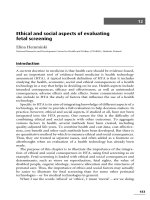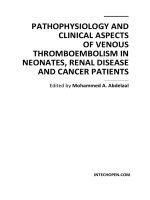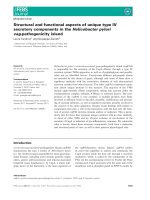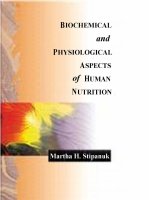Psychological and neurobiological aspects of eating disorders
Bạn đang xem bản rút gọn của tài liệu. Xem và tải ngay bản đầy đủ của tài liệu tại đây (1.83 MB, 174 trang )
Nathalie Tatjana Burkert
Psychological and
Neurobiological Aspects
of Eating Disorders
A Taste-fMRI Study in Patients
Suffering from Anorexia Nervosa
Psychological and Neurobiological Aspects
of Eating Disorders
Nathalie Tatjana Burkert
Psychological and
Neurobiological Aspects
of Eating Disorders
A Taste-fMRI Study in Patients Suffering
from Anorexia Nervosa
Nathalie Tatjana Burkert
Graz, Österreich
Zugl. Dissertation, Medizinische Universität Graz 2015
OnlinePlus material to this book can be available on
/>ISBN 978-3-658-13067-1
ISBN 978-3-658-13068-8 (eBook)
DOI 10.1007/978-3-658-13068-8
Library of Congress Control Number: 2016935721
© Springer Fachmedien Wiesbaden 2016
This work is subject to copyright. All rights are reserved by the Publisher, whether the whole or part
of the material is concerned, specifically the rights of translation, reprinting, reuse of illustrations,
recitation, broadcasting, reproduction on microfilms or in any other physical way, and transmission or
information storage and retrieval, electronic adaptation, computer software, or by similar or dissimilar
methodology now known or hereafter developed.
The use of general descriptive names, registered names, trademarks, service marks, etc. in this
publication does not imply, even in the absence of a specific statement, that such names are exempt
from the relevant protective laws and regulations and therefore free for general use.
The publisher, the authors and the editors are safe to assume that the advice and information in this
book are believed to be true and accurate at the date of publication. Neither the publisher nor the
authors or the editors give a warranty, express or implied, with respect to the material contained
herein or for any errors or omissions that may have been made.
Printed on acid-free paper
This Springer imprint is published by Springer Nature
The registered company is Springer Fachmedien Wiesbaden GmbH
To the most important individuals in my life –
Albert, Frederick and Fluffy.
Thank you for your endless love and support.
I love you more than anything.
You’ll be in my heart forever.
Acknowledgements
I dearly want to thank many people who have supported me during the
last four years as I conducted this study and wrote this thesis.
First of all, I want to thank my supervisor, principal, and mentor Univ.Prof. Dr. Wolfgang Freidl who made it possible in the first place to conduct this study. He supported me during the past few years with his
broad knowledge, encouraged me to do research in my fields of interest
and always gave me advice concerning methodological as well as theoretical questions. His invaluable support throughout my career has enabled me to become the researcher I am today. I am incredibly thankful
to him.
I also want to thank Univ.-Doz. Dr. Elfriede Greimel and Univ.-Prof. Dr.
Peter Stix who supported and supervised me while doing this research in
the field of eating disorders.
I especially want to thank Mag. Dr. Karl Koschutnig for his support with
the MRI measurement and data analyses. He was indispensable and an
incredible help for this study, giving me methodological and theoretical
advice concerning arising brain- and fMRI-related questions. In addition
to this, he supported me concerning data proceeding, analyses of fMRI,
and interpretational questions. Thank you so much for everything!
I want to thank Univ.-Prof. Dr. Th. Hummel for showing me his department and for explaining to me how his team conducts fMRI studies.
I thank my external supervisor Emilia Iannilli, PhD who gave me constructive advice concerning methodological questions related to the MRI
set-up, especially the modification of the MRI in order to be able to administer fluids to the participants. Additionally, she supported me in
data preproceeding questions, analyses, and interpretation. Thank you
very much for your time and effort.
8
Acknowledgements
I am very thankful to Univ.-Prof. Dr. Walter H. Kaye. He was the researcher who inspired me to conduct the present study and has been very
supportive throughout the past few years. I am deeply thankful to him
and his team for supportive discussions and their guidance regarding the
MRI measurements.
I also want to thank Univ.-Prof. Dr. Brian Lask for many supportive discussions about content-related issues.
I would like to thank all my colleagues at the Institute of Social Medicine
and Epidemiology, especially Univ.-Prof. Dr. Éva Rásky, Univ.-Prof. Dr.
Willibald J. Stronegger, Dr. Franziska Großschädl, MSc BSc, and Univ.Prof. MMag. Dr. Johanna Muckenhuber for discussing arising questions
concerning my thesis and giving valuable input to improve the quality of
my work. Thank you very much.
The project was conducted in cooperation with the Clinic of Neuroradiology and I would like to thank the clinic staff, and especially their
director, Univ.-Prof. Dr. Franz Ebner, for their support. If Univ.-Prof. Dr.
Franz Ebner had not endorsed my wish to conduct a taste study, I would
not have been able to do this research.
The MRI study I conducted made financial support necessary. Among
other things, I needed grants to buy the necessary equipment and to
modify the MRI to be able to administer fluids to the participants. Therefore, I wholeheartedly want to thank Land Steiermark for funding this
study. Without their support, I would not have been able to implement
this project. I would also like to thank the doctoral school, “Sustainable
health research”, at the Medical University Graz for their financial support. Without their grants I would not have been able to do this research.
Additionally, I would like to thank all clinicians who helped recruiting
the study’s participants, especially Dr. Claudia Bieberger, Hilde
Brandtner, DSA, Univ.-Prof. Dr. Marguerite Dunitz-Scheer, Dipl.-Psych.
Stefanie Gruber, Univ.-Prof. Dr. Peter Scheer, and Univ.-Prof. DDr.
Acknowledgements
9
Michael Lehofer. I also want to thank the BG/BRG Klusemannschule for
allowing me to introduce my study to the students there, thus enabling
me to recruit healthy control women.
I am indebted to the participating women who have dedicated their time
and given their effort supporting this project.
I am deeply thankful to my friends who have been there for me in the
past few years, who encouraged me when I felt hopeless and supported
me in stressful, but also joyful days. I would like to especially thank Nina
Brand, Barbara Welten, Christiane Steinhöfler, Aurelia Berger, Daniela
Raymitz, DI (FH) Ralf Wießpeiner, Mag. Clemens Schuster, Mag. Denise
Nittel, Mag. Dr. Evelin Singewald, and Dr. Majda Köck-Deutsch. Additionally, I would like to thank Dr. Gertraud Diestler for always having a
sympathetic ear, and Dr. Birgit Kirsten Steinbrenner for her endless support in all the good and bad times of my life. Thank you all so much.
Most of all, I dearly want to thank my parents for being there for me for
my entire life in such a supportive and loving manner, emotionally, intellectually, and financially. I will always love you.
I want to thank my beloved sisters, Dr. Nicole Weirich, Mag. Renée
Georgiev, and Désirée Burkert-Sridhar, LL.B. You are not only my family,
but also my soul-mates. You are in my heart forever.
I would also like to thank my nephew and nieces – Julian and Marie,
Kaiya and Miya, Marietta and Carlotta – for letting me see the world
through their wonderful eyes.
I would like to thank my deeply loved dog Fluffy who loves me the way I
am, who is always there for me and is the best friend I have ever had.
You will always be in my heart.
With all my love I want to thank my beloved husband, companion and
friend DI (FH) Albert who has always been there for me in good and bad
10
Acknowledgements
times in the past few years, accepts and loves me, has been supportive
and understanding and who I can laugh with – even though times might
be stressful. I love you more than anything.
Last but not least, I want to thank my dear son Frederick who I love in all
respects. He brought light into my life and always gives me hope, joy,
happiness, and love. I love you more than anything forever.
Contents
ZUSAMMENFASSUNG ............................................................................ 21
ABSTRACT ................................................................................................. 25
1
SCIENTIFIC BACKGROUND ............................................................... 29
1.1
INTRODUCTION .................................................................................... 29
1.2
ANOREXIA NERVOSA .............................................................................. 30
1.2.1
Medical issues and complications of the disease ........................ 34
1.2.2
Psychopharmacological treatment ............................................ 34
1.2.3
Recovery ................................................................................... 35
1.3
PSYCHOLOGICAL ASPECTS OF ANOREXIA NERVOSA ......................................... 36
1.3.1
Etiopathogenetic factors ........................................................... 36
1.3.2
Personality aspects.................................................................... 37
1.3.3
Stress and Coping ...................................................................... 38
1.3.4
Self-injurious behavior, suicide and mortality ............................. 38
1.4
NEUROBIOLOGICAL ASPECTS OF ANOREXIA NERVOSA ...................................... 40
1.4.1
Structural changes .................................................................... 41
1.4.2
Structural alteration of the hippocampus ................................... 43
1.4.3
Neurobiological aspects concerning taste processing ................. 45
1.4.4
Brain activity as a response to body images ............................... 46
1.4.5
Cognitive processing of taste-related stimuli .............................. 47
1.4.6
Viewing images of food ............................................................. 49
1.4.7
Administration of taste stimuli................................................... 51
2
METHOD.......................................................................................... 57
2.1
OBJECTIVES ......................................................................................... 57
2.2
PARTICIPANTS ...................................................................................... 58
2.2.1
Inclusion and exclusion criteria .................................................. 58
2.3
TEST PROCEDURE .................................................................................. 59
2.4
MRI DESIGN ........................................................................................ 65
2.4.1
Magnetic resonance measurement ............................................ 65
2.4.2
Taste stimulation ...................................................................... 66
2.5
DATA ANALYSIS .................................................................................... 69
2.5.1
Sociodemographic, medical and psychological data ................... 69
2.5.2
Structural brain data ................................................................. 70
12
Contents
2.5.3
3
fMRI data .................................................................................. 71
RESULTS........................................................................................... 73
3.1
CHARACTERISTICS ................................................................................. 73
3.1.1
General characteristics .............................................................. 73
3.1.2
Health behavior......................................................................... 74
3.1.3
Weight limit .............................................................................. 75
3.1.4
Psychiatric disorders in relatives ................................................ 75
3.1.5
Co-morbid disorders .................................................................. 75
3.1.6
Medical issues/complications .................................................... 76
3.1.7
Treatment and medication ........................................................ 76
3.1.8
Subjective health ....................................................................... 76
3.2
PSYCHOLOGICAL ASPECTS OF ANOREXIA NERVOSA ......................................... 77
3.2.1
Personality ................................................................................ 77
3.2.2
Coping Strategies ...................................................................... 78
3.2.3
Body perception ........................................................................ 79
3.2.4
Eating disorder symptoms ......................................................... 80
3.2.5
Depression and anxiety ............................................................. 81
3.2.6
Obsessive-compulsive symptoms ............................................... 82
3.2.7
Medical complaints ................................................................... 83
3.2.8
Self harm and suicidality............................................................ 84
3.2.9
Quality of life ............................................................................ 85
3.3
NEUROBIOLOGICAL ASPECTS OF ANOREXIA NERVOSA ...................................... 86
3.3.1
Structural changes in overall brain volume and volume of the
various brain areas.................................................................... 86
3.3.2
Volume of the hippocampal sub-structures ................................ 89
3.3.3
Associations between the total hippocampal volume and other
brain areas, stress, and coping .................................................. 91
3.3.4
Brain activity in response to taste stimuli: whole brain analyses . 93
3.3.5
Brain activity in response to the different taste stimuli in the
regions of interest ..................................................................... 95
3.3.6
Associations between the brain activity in response to a taste in
general and psychological aspects ............................................. 98
4
DISCUSSION ................................................................................... 115
4.1
PSYCHOLOGICAL ASPECTS OF ANOREXIA NERVOSA ....................................... 115
4.1.1
Personality .............................................................................. 117
4.1.2
Stress and coping .................................................................... 118
Contents
13
Body image ............................................................................. 119
4.1.3
4.2
NEUROBIOLOGICAL ASPECTS OF ANOREXIA NERVOSA .................................... 120
4.2.1
Structural changes .................................................................. 120
4.2.2
Hippocampal changes and associations with psychological
symptoms in AN patients......................................................... 121
4.2.3
Brain activity as a response to a taste in general...................... 124
4.2.4
Brain activity as a response to sucrose, umami, and citric acid in
regions of interest ................................................................... 126
4.2.5
Associations between the brain activity as a response to a taste
and psychological factors ........................................................ 128
4.3
A CRITICAL REFLECTION OF THE CURRENT STUDY .......................................... 130
4.4
STRENGTHS AND LIMITATIONS ................................................................ 132
4.5
IMPLICATIONS AND CONCLUSIONS ........................................................... 134
5
REFERENCES .................................................................................. 137
6
APPENDIX ...................................................................................... 171
Additional material (appendix: declaration of consent and questionnaires
in German) can be downloaded at the webpage of this book at
www.springer.com.
Abbreviations
ACC
AI
AN
BA
BDI
BMI
BN
BOLD
CA
CC
CW
DG
DLPFC
DSM-IV
DTI
ED
EDs
EDI-2
FBeK
FPI-R
fMRI
FC
FG
FO
FWE
GABA
HZI-K
IPL
ICD-10
LV
M
Anterior cingulated cortex
Anterior insula
Anorexia nervosa
Brodmann area
Beck Depression Inventory
Body Mass Index
Bulimia nervosa
Blood oxygenation level dependent
Cornu ammonis areas
Corpus callosum
Healthy control women
Dentate gyrus
Dorsolateral prefrontal cortex
Diagnostic and Statistical Manual of Mental Disorders
Diffusion tensor imaging
Eating disorder
Eating disorders
Eating disorder inventory 2
Questionnaire concerning attitudes toward ones own
body
Freiburger Personality Inventory
functional Magnetic Resonance Imaging
Frontal cortex
Frontal gyrus
Frontal operculum
Family wise error
Gamma aminobutyric acid
Hamburger Obsessive-Compulsive Behavior Inventory
Inferior parietal lobule
International Classification of Diseases
Lateral ventricle
Mean
16
Abbreviations
MANOVA
Multivariate analyses of variance
MR
Magnetic Resonance
OFC
Orbifrontal cortex
PCG
Postcentral gyrus
PET
Positron Emission Tomography
PFC
Prefrontal cortex
PHG
Parahippocampal gyrus
PTSD
Post-traumatic stress disorder
SD
Standard deviation
SES
Socioeconomic status (class)
RAN
Women recovered from anorexia nervosa
RBN
Women recovered from bulimia nervosa
ROI
Region of interest
SCL-90R
Symptom checklist
SIB
Self-injurious behavior
SITBI
Suicidal aspects and self injurious behavior
SPM
Statistical parametric mapping
STAI
State trait anxiety inventory
SVF-48
Coping questionnaire
T1R3
Type 1 member 3
WHO-QoL-bref World Health Organization Quality of Life questionnaire
List of figures
FIGURE 1: BRIEF SUMMARY OF BRAIN AREAS .............................................................. 40
FIGURE 2: EXPERIMENTAL SETUP FOR THE STUDY ......................................................... 66
FIGURE 3: SET-UP FOR TASTE FMRI ......................................................................... 68
FIGURE 4: VOLUME OF HIPPOCAMPAL SUBFIELDS IN AN VS. CW ..................................... 90
FIGURE 5: ASSOCIATION BETWEEN HIPPOCAMPAL VOLUME, STRESS AND POSITIVE COPING ..... 92
FIGURE 6: BETA ACTIVITY DUE TO THE ADMINISTRATION OF A TASTE IN GENERAL IN THE INSULA
[45,-4,1], THE ANTERIOR CINGULATE CORTEX [9,-46,4] AND THE FRONTAL CORTEX [24,32,-11] FOR AN AND CW .................................................................. 93
FIGURE 7: BETA-ACTIVITY DUE TO THE ADMINISTRATION OF SUCROSE, UMAMI, OR CITRIC ACID IN
THE ROIS INSULA [45,-4,1], ANTERIOR CINGULATE CORTEX [9,-46,4] AND FRONTAL
CORTEX [-24,32,-11] FOR AN AND CW ..................................................... 97
FIGURE 8: ASSOCIATION BETWEEN BRAIN ACTIVITY DUE TO THE ADMINISTRATION OF A TASTE IN
GENERAL AND STRESS IN THE ROIS INSULA [45,-4,1], ANTERIOR CINGULATE CORTEX
[9,-46,4] AND FRONTAL CORTEX [-24,32,-11] FOR AN AND CW ..................... 99
FIGURE 9: ASSOCIATION BETWEEN BRAIN ACTIVITY DUE TO THE ADMINISTRATION OF A TASTE IN
GENERAL AND ANXIETY RATINGS OF THE ADMINISTRATION OF A TASTE IN THE ROIS
INSULA [45,-4,1], ANTERIOR CINGULATE CORTEX [9,-46,4] AND BRODMANN AREA 1
[60,-28,40] FOR AN PATIENTS AND CW .................................................. 101
FIGURE 10: ASSOCIATION BETWEEN BRAIN ACTIVITY DUE TO THE ADMINISTRATION OF A TASTE IN
GENERAL AND DEPRESSION IN THE ROIS ANTERIOR CINGULATE CORTEX [9,-46,4]
FRONTAL CORTEX [-24,32,-11], AND PARAHIPPOCAMPAL GYRUS [21,-13,-14] FOR
AN PATIENTS AND CW.......................................................................... 104
FIGURE 11: ASSOCIATION BETWEEN BRAIN ACTIVITY DUE TO THE ADMINISTRATION OF A TASTE IN
GENERAL AND THE ANXIETY RATING IN THE SCL QUESTIONNAIRE FOR THE ROIS
ANTERIOR CINGULATE CORTEX [9,-46,4] FRONTAL CORTEX [-24,32,-11], AND
INFERIOR PARIETAL LOBE [42,-34,25] FOR AN PATIENTS AND CW .................. 107
FIGURE 12: ASSOCIATION BETWEEN BRAIN ACTIVITY DUE TO THE ADMINISTRATION OF A TASTE IN
GENERAL AND THE OBSESSION RATING IN THE SCL QUESTIONNAIRE FOR AN PATIENTS
AND CW IN THE ROIS ANTERIOR CINGULATE CORTEX [9,-46,4] FRONTAL CORTEX [24,32,-11], AND PARAHIPPOCAMPAL GYRUS [21,-13,-14] ........................... 109
FIGURE 13: ASSOCIATION BETWEEN BRAIN ACTIVITY DUE TO THE ADMINISTRATION OF A TASTE IN
GENERAL WITH OBSESSIONAL CONTROL IN THE HZI QUESTIONNAIRE FOR AN PATIENTS
AND CW IN THE ROIS INSULA [45,-4,1], ANTERIOR CINGULATE CORTEX [9,-46,4],
AND FRONTAL CORTEX [-24,32,-11] ........................................................ 112
18
List of figures
FIGURE 14: ASSOCIATION BETWEEN BRAIN ACTIVITY DUE TO THE ADMINISTRATION OF A TASTE IN
GENERAL WITH THE DURATION OF THE ILLNESS FOR AN PATIENT IN THE ROIS
ANTERIOR CINGULATE CORTEX [9,-46,4] FRONTAL GYRUS [-12,47,-8], AND
PARAHIPPOCAMPAL GYRUS [21,-13,-14] .................................................. 113
List of tables
TABLE 1: DIAGNOSTIC CRITERIA OF AN ACCORDING TO ICD-10 (WORLD HEALTH
ORGANIZATION, 1994) AND DSM-IV (AMERICAN PSYCHIATRIC ASSOCIATION,
1994) ................................................................................................ 32
TABLE 2: SUMMARY OF PREVIOUS STUDIES ANALYZING BRAIN ACTIVITY AS A RESPONSE TO TASTE
STIMULI IN PATIENTS WITH AN .................................................................. 54
TABLE 3: COLLECTED DATA CONCERNING PSYCHOLOGICAL ASPECTS .................................. 61
TABLE 4: BRIEF DESCRIPTION OF ALL QUESTIONNAIRES .................................................. 62
TABLE 5: MR MEASUREMENT PROTOCOL .................................................................. 65
TABLE 6: PERSONALITY CHARACTERISTICS OF AN VS. CW .............................................. 77
TABLE 7: COPING STYLES OF AN VS. CW ................................................................... 78
TABLE 8: BODY PERCEPTIONS OF AN VS. CW ............................................................. 79
TABLE 9: EATING DISORDER SYMPTOMS IN AN VS. CW ................................................ 80
TABLE 10: DEPRESSION AND ANXIETY IN AN VS. CW ................................................... 81
TABLE 11: OBSESSIVE-COMPULSIVE SYMPTOMS IN AN VS. CW ...................................... 82
TABLE 12: MEDICAL COMPLAINTS IN AN VS. CW ........................................................ 83
TABLE 13: SELF-HARM AND SUICIDALITY IN AN VS. CW ................................................ 84
TABLE 14: QUALITY OF LIFE IN AN VS. CW ................................................................ 85
TABLE 15: VOLUME OF THE VARIOUS BRAIN AREAS IN AN VS. CW ................................... 86
TABLE 16: DIFFERENCES IN HIPPOCAMPAL VOLUME BETWEEN AN AND CW ....................... 89
TABLE 17: DIFFERENCES BETWEEN AN PATIENTS AND CW IN BRAIN ACTIVITY DUE TO THE
ADMINISTRATION OF A TASTE IN GENERAL: WHOLE BRAIN ANALYSES .................... 94
TABLE 18: TEST STATISTICS CONCERNING DIFFERENCES IN THE BRAIN ACTIVITY DUE TO THE
ADMINISTRATION OF SUCROSE, UMAMI, OR CITRIC ACID BETWEEN AN PATIENTS AND
CW IN THE REGIONS OF INTEREST .............................................................. 96
TABLE 19: PEARSON’S CORRELATIONS COEFFICIENT OF BRAIN ACTIVITY WITH STRESS OF FMRIMEASUREMENT, AND GENERAL TASTE ANXIETY IN AN AND CW IN THE ROIS ....... 102
TABLE 20: PEARSON’S CORRELATIONS COEFFICIENT OF BRAIN ACTIVITY WITH TASTE
PLEASANTNESS RATINGS AND DEPRESSION IN AN PATIENTS AND CW IN THE ROIS 105
TABLE 21: PEARSON’S CORRELATIONS COEFFICIENT OF BRAIN ACTIVITY WITH ANXIETY, AND
OBSESSION IN AN PATIENTS AND CW IN THE ROIS ....................................... 110
TABLE 22: PEARSON’S CORRELATIONS COEFFICIENT OF BRAIN ACTIVITY WITH OBSESSIONAL
CONTROL AND DURATION OF ILLNESS IN AN PATIENTS AND CW IN THE ROIS ...... 114
20
List of tables
TABLE 23: TEST
STATISTICS CONCERNING DIFFERENCES IN BRAIN ACTIVITY DUE TO THE
ADMINISTRATION OF SUCROSE BETWEEN AN PATIENTS AND CW IN THE ROIS ..... 171
TABLE 24: TEST
STATISTICS CONCERNING DIFFERENCES IN BRAIN ACTIVITY DUE TO THE
ADMINISTRATION OF UMAMI BETWEEN AN PATIENTS AND CW IN THE ROIS ....... 173
TABLE 25: TEST
STATISTICS CONCERNING DIFFERENCES IN BRAIN ACTIVITY DUE TO THE
ADMINISTRATION OF CITRIC ACID BETWEEN AN PATIENTS AND CW IN THE ROIS .. 174
Zusammenfassung
Essstörungen (ED) sind in den westlichen Ländern eine der weitverbreitetsten und schwersten psychischen Erkrankungen. Eine Anorexia Nervosa (AN) zeichnet sich durch einen massiven Gewichtsverlust aus, der
durch eine Restriktion des Essverhaltens herbeigeführt wird. Charakteristika der Erkrankung sind ein anormales Essverhalten, Gewichtskontrolle, Körperschemastörungen und eine beeinträchtigte Stimmung. Studien konnten Veränderungen in der Größe des Gehirns in einzelnen
Gehirnarealen bei PatientInnen mit einer Essstörung belegen. Zusätzlich
konnte man bei PatientInnen, die an einer AN leiden, funktionelle Gehirnveränderungen in Regionen feststellen, die für die Regulation des
Essverhaltens zuständig sind. PatientInnen mit einer AN zeigten auch
nach der Heilung noch eine veränderte Gehirnaktivität in der Insula,
dem orbifrontalen Cortex, dem mesialen temporalen, parietalen und anterioren cingulären Cortex als Reaktion auf die Verabreichung eines Geschmacksreizes. Bei PatientInnen mit AN könnte daher die Veränderung
der Gehirnaktivität bei der Antizipation von Essensreizen Verhaltensstrategien zur Vermeidung von Nahrung induzieren. Bisher wurde bei
PatientInnen, die an einer Anorexie leiden, in den meisten Untersuchungen lediglich die Gehirnaktivität als Reaktion auf einen süßen
Geschmacksreiz (Zuckerlösung, Kakao und Milch-Schakes) untersucht,
da man annimmt, dass dies ein positiver Stimulus ist. Daher war es das
Ziel der vorliegenden Untersuchung, psychologische Faktoren, die mit
der Erkrankung einhergehen sowie strukturelle Gehirnveränderungen
und Veränderungen in der Gehirnaktivität bei der Verarbeitung von
Nahrungsreizen als Reaktion auf verschiedene Geschmacksreize (süß,
sauer und herzhaft) zu untersuchen sowie potenzielle Assoziationen zwischen den neurobiologischen Veränderungen und den psychologischen
Faktoren zu überprüfen.
Eine Gruppe von 21 Frauen, die an einer Anorexia Nervosa litten
und 21 gesunde altersgematchte Frauen (CW) wurden untersucht. Daten
hinsichtlich psychologischer Variablen wurden mittels Fragebogen erhoben. Die Größe des Gehirns und funktionelle Gehirndaten wurden mit
22
Zusammenfassung
einem 3 Tesla Magnetresonanzscanner (MRI) während der Verabreichung von drei verschiedenen Geschmacksreizen (150mMol Zuckerlösung, 50mMol Zitronensäurelösung und 50mMol Monosodium Glutamatlösung) im Vergleich zu einem neutralen Geschmacksreiz gemessen.
Die Daten hinsichtlich psychologischer Aspekte der Erkrankung wurden
mittels Multivariater Varianzanalyse (MANOVA) analysiert. Unterschiede in den Volumina der Gehirnareale zwischen den Gruppen AN
und CW wurden mittels Varianzanalyse, Unterschiede in den hippocampalen Substrukturen mittels MANOVA untersucht. Zusätzlich wurden
Korrelationen zwischen der Größe des Hippocampus mit Stress, positiven und negativen Stressverarbeitungsstrategien berechnet.
Mittels der Software SPM wurden die funktionellen Gehirndaten
analysiert. Nach der Vorverarbeitung der Daten wurden Gruppenunterschiede in der Gehirnaktivität als Reaktion auf einen Geschmacksreiz im
Allgemeinen untersucht. Basierend auf diesen Ergebnissen wurde in
einem weiteren Schritt eine Region of interest (ROI)-Analyse durchgeführt.
Hierzu wurden Unterschiede in der Gehirnaktivität zwischen den beiden
Gruppen AN und CW als Reaktion auf einen süßen, sauren oder herzhaften Geschmacksreiz in den ROIs mittels MANOVA untersucht. Zusätzlich wurden Korrelationen zwischen der durchschnittlichen BetaAktivität als Reaktion auf die Verabreichung eines Geschmacksreizes im
Allgemeinen in den ROIs mit psychologischen Daten wie beispielsweise
Stress, der Beurteilung der Geschmäcker, Ko-Morbiditäten und der
Erkrankungsdauer berechnet.
Die Ergebnisse dieser Untersuchung zeigten, dass Patientinnen
mit einer AN spezielle Persönlichkeitscharakteristika wie Emotionalität,
Perfektionismus oder soziale Unsicherheit aufweisen. Viele der untersuchten Patientinnen litten an den klassischen Ko-Morbiditäten Depressionen, Angst- oder Zwangsstörungen. Die Frauen in der Gruppe AN
beurteilten ihren subjektiven Gesundheitszustand sowie ihre Lebensqualität niedriger als jene in der CW-Gruppe. Zusätzlich zeigten sich Defizite
in der Stressverarbeitung und Störungen in der Körperwahrnehmung bei
Patientinnen mit einer AN.
Zusammenfassung
23
Bei Patientinnen mit AN wurde ein selektiver Volumensverlust in speziellen Gehirnregionen (dem kortikalen Gehirnvolumen insgesamt, in
der grauen Gehirnmasse, dem Corpus callosum, dem Thalamus, dem
Choroid Plexus und in der Amygdala) festgestellt. Es zeigten sich Zusammenhänge zwischen der Größe des Hippocampus mit psychologischen Variablen wie Stress und Stressverarbeitungsstrategien. Zusätzlich
wurden auch Unterschiede in der Geschmacksverarbeitung in speziellen
Gehirnregionen, die für Belohnungsverhalten, das Fällen von Entscheidungen, für emotionale Reaktionen, Kontrollverhalten und für die Integration verschiedener Informationen verantwortlich sind, wie beispielsweise der Insula, dem anterioren cingulären Cortex oder dem orbifrontalen Cortex, unabhängig von der Geschmacksmodalität, festgestellt. Die
Untersuchung zeigte auch einen Zusammenhang zwischen der
Geschmacksverarbeitung mit psychologischen Variablen wie Stress,
Ängstlichkeit, Ko-Morbiditäten und der Erkrankungsdauer auf.
Aufgrund der Unzugänglichkeit des Gehirns sind bislang kaum
Informationen über physiologische Korrelate von Verhaltensstörungen
verfügbar. Bildgebende Verfahren ermöglichen die Gewinnung neuer
Erkenntnisse über strukturelle und funktionelle Gehirnveränderungen,
die – in Interaktion mit psychologischen und sozialen Faktoren sowie
Umwelteinflüssen – zur Entwicklung und/oder Aufrechterhaltung von
Essstörungen beitragen können. Insgesamt fördern die Ergebnisse der
Untersuchung ein besseres Verständnis der Pathophysiologie der Erkrankung, was dazu beitragen kann, einen darauf begründeten Ansatz
für die Therapie zu entwickeln.









